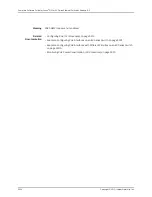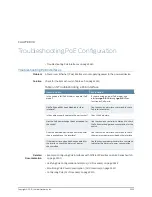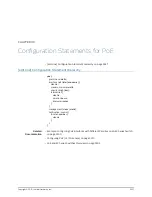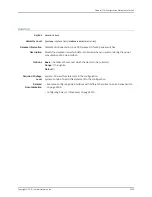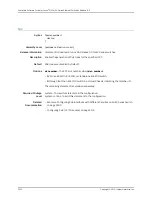
Table 442: PoE Configurable Options and Default Settings
(continued)
Description
Default
Option
Sets an interface’s power priority to either
low
or
high
. If power is
insufficient for all PoE interfaces, the low priority interfaces are shut
down before the high priority interfaces. Among interfaces that have the
same assigned priority, the power priority is determined by port number,
with lower- numbered ports having higher priority.
low
priority
When included in the configuration, enables the logging of power
consumption records on an interface. Logging occurs every five minutes
for one hour unless you specify a different
interval
or
duration
.
Not included in default
configuration
telemetries
Sets the maximum power that can be delivered by a PoE interface. The
maximum power allowed is the same as the default—either 15.4 W for
switches that support IEEE 802.3af (PoE) or 30.0 W for switches that
support IEEE 802.3af (PoE+).
This setting is ignored if the power management mode is
class
.
15.4
W (for switches that
support IEEE 802.3af)
30.0
W (for switches that
support IEEE 802.3at)
maximum-power
When included in the configuration, disables PoE on the interface. The
interface maintains network connectivity but no longer supplies power
to a connected powered device. Power is not allocated to the interface.
Not included in default
configuration
disable
To configure PoE:
1.
To change power management mode from the default class mode to static mode:
[edit poe]
user@switch# set management static
NOTE:
On an EX2200 switch, we recommend that you do not change the
default management mode. The PoE power budget for an EX2200 switch
is 405 W. If you change the power management mode to static mode, the
PoE controller allocates 30.0 W for each port on the EX2200 switch, which
means only 13 ports receive power. With the default priority settings, the
13 ports that receive power are the first 13 ports.
In class mode, on the other hand, the PoE controller does not allocate
power to a port until a powered device is connected. The class of the
connected device determines the amount of power allocated. Thus in
class mode, any PoE port can be used to power a device and all the PoE
ports on the switch can be used as long as the combined power demand
does not exceed 405 W.
2.
To reserve a specified wattage of power in case of a spike in PoE consumption:
[edit poe]
user@switch# set guard-band 15
3.
To configure a number of interfaces with the same settings (for example, to enable
telemetry collection on all interfaces):
Copyright © 2010, Juniper Networks, Inc.
3316
Complete Software Guide for Junos
®
OS for EX Series Ethernet Switches, Release 10.3
Summary of Contents for JUNOS OS 10.3 - SOFTWARE
Page 325: ...CHAPTER 17 Operational Mode Commands for System Setup 229 Copyright 2010 Juniper Networks Inc ...
Page 1323: ...CHAPTER 56 Operational Mode Commands for Interfaces 1227 Copyright 2010 Juniper Networks Inc ...
Page 2841: ...CHAPTER 86 Operational Commands for 802 1X 2745 Copyright 2010 Juniper Networks Inc ...
Page 3367: ...CHAPTER 113 Operational Mode Commands for CoS 3271 Copyright 2010 Juniper Networks Inc ...
Page 3435: ...CHAPTER 120 Operational Mode Commands for PoE 3339 Copyright 2010 Juniper Networks Inc ...
Page 3529: ...CHAPTER 126 Operational Mode Commands for MPLS 3433 Copyright 2010 Juniper Networks Inc ...























